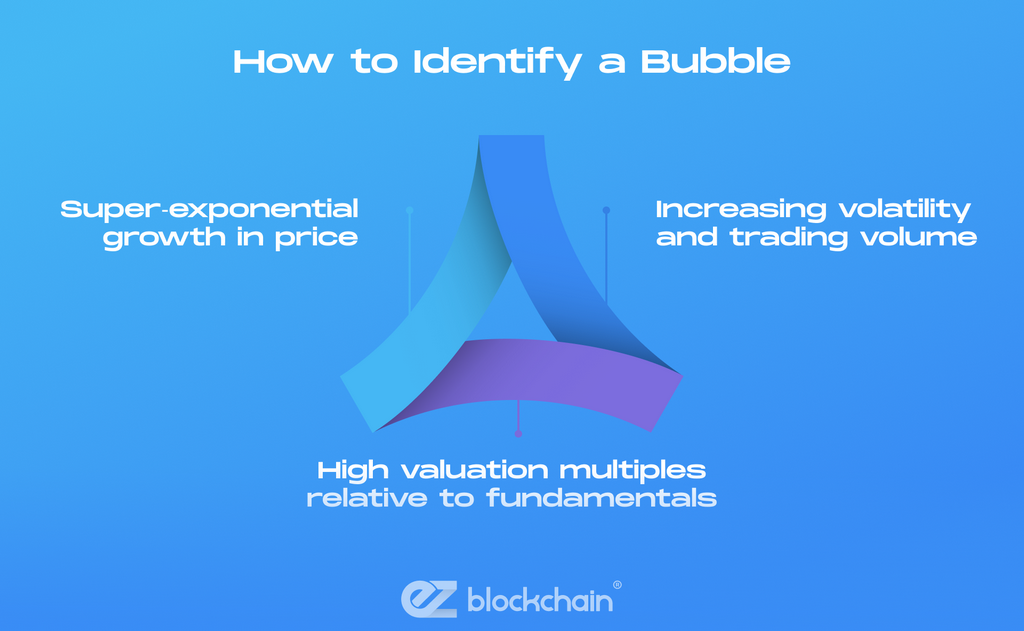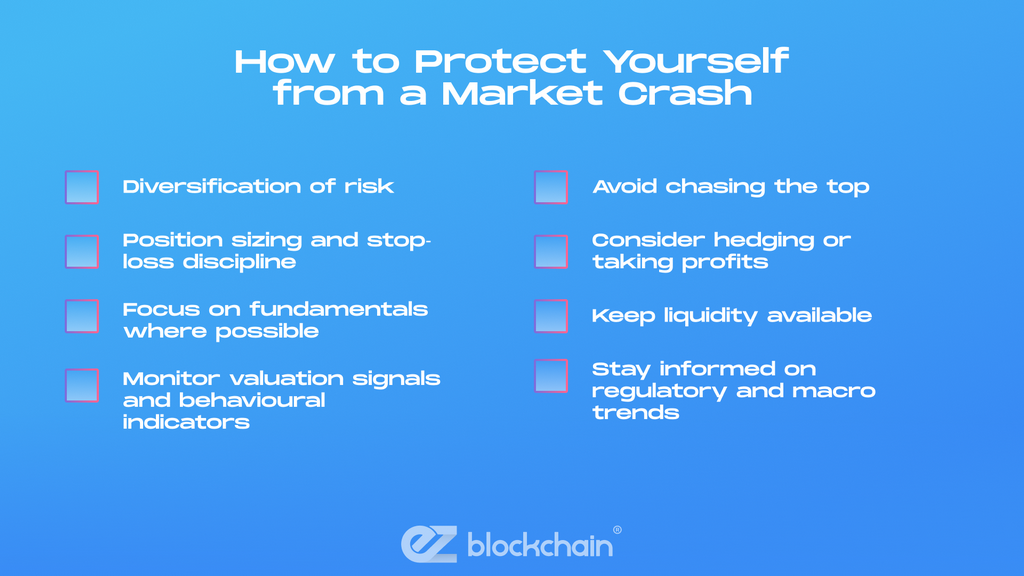Stay up to date with the latest news, announcements, and articles.
What Is a Crypto Bubble?
At its core, a “bubble” in the context of crypto assets refers to a situation in which the market valuation of assets (such as Bitcoin, ether, or broader crypto‑asset indices) diverges dramatically from any plausible fundamental value, often driven by speculative flows, herding, and a positive‑feedback loop of price → hype → more price. Important technical hallmarks include super‑exponential growth over a finite horizon, followed by a regime shift or crash.
Economists like Maarten R. C. van Oordt has formalised the notion: if an asset’s price cannot be justified by transactional or intrinsic utility (for crypto arguably token‑network demand) but rather requires continued new inflows to sustain price, then we may be dealing with a rational bubble.
In technical econometric terms, tests such as RTADF, GSADF and SADF have been applied to crypto time‑series to detect “explosive behaviour” (i.e., deviations from standard unit‑root or mean‑reverting models) consistent with bubbles. For example, one study applied GSADF to bitcoin price data and found multiple bubble episodes.

Historical Examples: 2017 and 2021
The first broadly recognised crypto bubble peaked in December 2017: Bitcoin rose from under US $1,000 at the start of 2017 to nearly US $20,000 by December. Subsequent months saw a steep correction. Many narratives attribute this to hype, retail mania, and the ICO wave. According to one study, the non‑bubble component of Bitcoin’s price in 2024 was estimated at US $54, implying that >99% of the value at peak might have been a bubble. Manipulation was also alleged: a June 2018 study indicated that large‑scale issuance of the stable‑coin Tether may have driven up Bitcoin’s price in 2017.
A more recent bubble (or series of bubbles) occurred around 2020‑2021. The total crypto‑asset market capitalisation reached ~US $2.481 trillion on 12 May 2021. A detailed study using the Log‑Periodic Power Law Singularity (LPPLS) model identified the boom from Nov 2020 to Jan 2021 as an endogenous bubble driven by herding and imitation, and the spike from Jan to Apr 2021 as exogenous, driven by institutional adoption (e.g., Tesla, Visa) and external events. More recently, a report by the European Central Bank noted that in 2024 crypto‑asset valuations reached ~US $3.7 trillion before falling to ~US $2.8 trillion by end‑March 2025.
| Period | Asset/Market | Approximate Peak Valuation | Core Drivers | Aftermath / Correction |
| 2017 | Bitcoin & alt‑coins | BTC ~ US $20,000 | Retail mania, ICO hype | ~70‑80%+ crash in following year |
| 2020‑21 | Crypto market (~all) | Total cap ~ US $2.48 trillion | Institutional adoption + hype | Multi‑month correction starts Apr 2021 |
| 2024 | Crypto market | Total cap ~ US $3.7 trillion | ETF & regulatory tailwinds | Fall to ~US $2.8 trillion by Mar 2025 |
If one draws a line across these numbers, we can see successive higher peaks, shorter intervals, and increasing institutional involvement.
How to Identify a Bubble
Identifying a bubble in real time is difficult, but several quantitative and behavioural signals can help:
- Super‑exponential growth in price: If log‑price growth appears convex (accelerating faster than exponential) it can signal positive feedback loops. For example, the LPPLS model captures this feature.
- High valuation multiples relative to fundamentals: For crypto, since traditional cash‑flow models fail, analysts compare price to network metrics (e.g., Metcalfe’s law, transaction volume). Van Oordt highlights that if price is justified only by future inflows (rather than utility) it may be a bubble.
- Increasing volatility and trading volume: Studies show that bubble periods in crypto correlate with higher volatility and volume.
Investor Psychology and Market Hype
Bubble formation is as much behavioural as it is quantitative. Key psychological features include:
- Herd behaviour and imitation: Investors copy others, conceiving that “if others are making money, I’ll be left behind”. The LPPLS model formalises this positive feedback loop between price moves and investor behaviour.
- Overconfidence and extrapolation: Market participants assume recent gains will continue indefinitely; extreme optimism dominates.
- Fear of missing out (FOMO): Especially in crypto, social media and app‑based trading inflate the sense of urgency.
- Confirmation bias and narrative‑driven belief: The narrative (e.g., “Bitcoin is digital gold”, blockchain is future) lends psychic support to rising prices, even when fundamentals lag.
- Rationalising high valuations: Investors rationalise outlandish valuations by resorting to future possibilities, ignoring the present mismatch with utility or cash‑flow.
The behavioural drivers fuel the technical mechanics: herding leads to volume and price acceleration, which in turn attracts more participants, creating a self‑reinforcing cycle — until it breaks.

Are We Currently in a Bubble?
One important shift: institutional behaviour has accelerated. For example, launch of spot Bitcoin ETPs in the U.S. (January 2024) increased institutional access. The ECB document notes that this institutional expansion is a driver of the 2024 boom. Institutional involvement can either mitigate or exacerbate bubbles: while they bring more capital and ostensibly better analysis, they can also amplify flows.
To answer the question “is crypto a bubble now?” The evidence leans toward yes, there are strong bubble‑like characteristics. The market cap is enormous, valuation frameworks remain weak, retail and institutional flows are intense, and behavioural indicators (hype, FOMO) are elevated. Whether we are in the peak phase or just before the peak is far harder to determine with precision.
How to Protect Yourself from a Market Crash
Given the risk of bubble collapse, here are technical and strategic precautions:
- Diversification of risk: Do not allocate all capital to high‑volatility assets. Crypto assets historically experience large drawdowns.
- Position sizing and stop‑loss discipline: Determine a maximum loss you are willing to absorb and stick to it.
- Focus on fundamentals where possible: Prefer crypto‑assets with demonstrable use‑cases, strong network activity, and capital efficiency. Avoid purely speculative “meme‑coins” or hype‑driven launches.
- Monitor valuation signals and behavioural indicators: Use metrics such as price acceleration, volume surges, network usage, investor sentiment, and econometric bubble tests (although the latter are mostly academic).
- Avoid chasing the top: Late‑cycle buying tends to lead to high entry‑points and larger downside.
- Consider hedging or taking profits: In high‑risk markets, locking in gains or reducing exposure makes sense.
- Keep liquidity available: A crash will often come abruptly; having non‑invested capital enables flexibility.
- Stay informed on regulatory and macro trends: Crypto is highly sensitive to regulatory shifts, macro policy, liquidity flows.
In summary, protecting yourself means acknowledging the risk of a crash, acting accordingly with risk‑management discipline, and staying humble about what one does not know.

Long‑Term Lessons from Past Cycles
Several lessons emerge from the 2017 and 2021 episodes that are applicable for high‑performance investors in crypto markets:
- Cycles repeat, but not identically: The 2017 and 2021 bubbles differ in scale, duration, participation and institutional involvement. Be wary of assuming history repeats in exact form.
- Valuation frameworks matter: Without an underlying utility or measurable fundamental, speculative assets become vulnerable. The divergence between price and fundamentals is a warning sign.
- Investor psychology is central: Behavioural tilt (herding, FOMO, narrative) is as important as the technical mechanics of price.
- Interconnectedness increases risk: As crypto markets grow, contagion among assets and spill‑over risk intensify. The “co‑explosivity” findings show this.
- Institutional era adds complexity: Institutional flows bring both stability and new vulnerabilities (e.g., leverage, products, derivatives).
- Risk of staying in too long is real: Many retail investors enter near the peak and experience the bulk of the downside. Timing is critical.
- Regulatory risk increases with size: As the crypto ecosystem becomes systemic in scale, policy interventions or structural risks (e.g., mining regulation) increasingly matter.
Over the longer term, the assets that provide real network utility (transactions, smart‑contracts, infrastructure) may survive; pure speculation may not. For high‐performance investors, preserving capital during the correction often matters more than chasing the last increments of upside.
FAQ
What exactly differentiates a “crypto bubble” from a normal market correction?
A normal correction reflects a moderate decline after a price build‑up; a bubble implies valuations grew unsustainably, decoupled from fundamentals, and a crash is likely to be deep and abrupt. Tests such as LPPLS or GSADF detect super‑exponential growth rather than simple mean reversion.
Is it too late to protect myself if I’m already heavily invested?
No – while the easiest risk‑mitigation occurs pre‑peak, even post‑peak you can reduce exposure, hedge, diversify, lock in gains, or move to more fundamental‑oriented crypto assets.
Can crypto never be a bubble because it’s a new asset class?
The novelty of crypto doesn’t preclude bubbles. In fact, new asset classes may be more prone to speculative bubbles because fundamental metrics are less established. Research shows crypto bubbles in magnitude exceed prior historical bubbles.
If we are already in a bubble, when will it burst?
Timing a bubble burst is extremely difficult. Even models (LPPLS, GSADF) provide estimates but not precise dates. The key is to manage risk proactively, rather than predict the exact moment of collapse.
Does institutional involvement reduce the risk of a bubble?
Not necessarily. While institutional capital brings more sophistication, it also can amplify flows, leverage and systemic risk. Moreover, institutional participation often comes later in the cycle — which might suggest the bubble is more mature.
Fill out a form and our bitcoin mining expert will contact you.
FREE CONSULTATIONchoose
a miner
profit and
understand data?
business remotely
with EZ Blockchain?
Fill out a form and our bitcoin mining expert will contact you.









